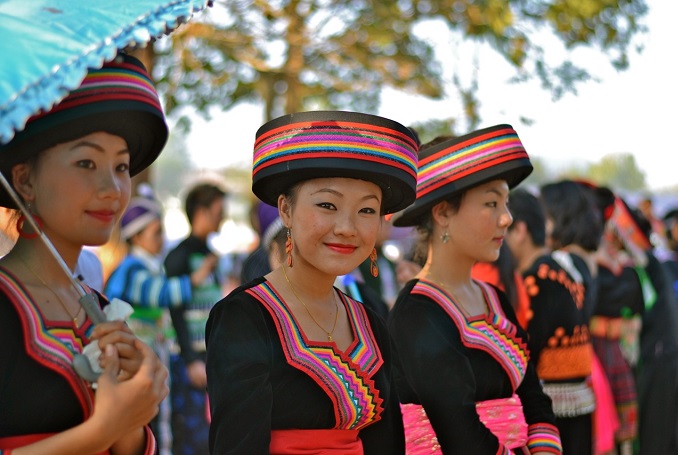Lao Foods
Although the Lao Food or Laotian food, is making waves across the world – it’s rightfully gaining popularity – it still
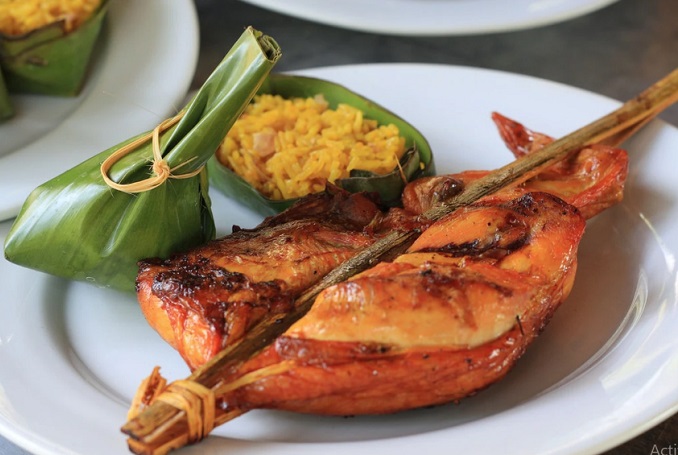 has so much more potential.
has so much more potential.1, Khao Soi (Rice Noodle Soup With Fermented Soybean-Tomato Sauce)
Khao soi, which means “cut noodle,” is a dish found in both Isan and northern Laos. Luangrath says she learned to make khao soi about 15 years ago while visiting her sister, whose mother-in-law was from northern Laos. “I’d never had it, and she happened to make it that day, and I was like, ‘What is this, is this Laos food? I didn’t know this kind of noodle existed in Laos.’”
For khao soi, fresh, wide-cut rice noodles are covered with a broth made from chicken bones and herbs. The soup
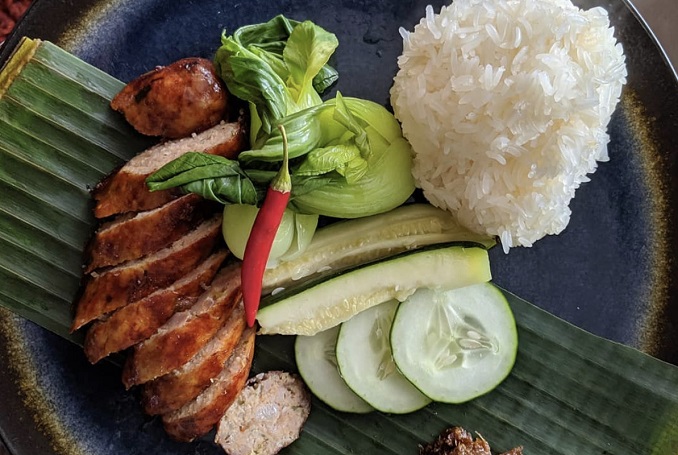 gets topped with a sauce made from tomato, vinegar, palm sugar, chile powder, and thua nao, a type of Lao fermented soybean paste that incorporates chile paste and has a flavor similar to the Korean fermented bean paste ssamjang. Luangrath says thua nao is a regionally specific ingredient that originates from the town of Muang Sing, close to the Chinese border. “It’s very funky and intense in flavor because it’s fermented for months and months,” she adds. Common toppings for the soup are scallion, cilantro, watercress, and water spinach.
gets topped with a sauce made from tomato, vinegar, palm sugar, chile powder, and thua nao, a type of Lao fermented soybean paste that incorporates chile paste and has a flavor similar to the Korean fermented bean paste ssamjang. Luangrath says thua nao is a regionally specific ingredient that originates from the town of Muang Sing, close to the Chinese border. “It’s very funky and intense in flavor because it’s fermented for months and months,” she adds. Common toppings for the soup are scallion, cilantro, watercress, and water spinach.2, Khao Niew (Lao Sticky Rice)
Rice is perhaps the most fundamental food in Laos, forming the basis for every meal. It’s often the first dish that home cooks, usually women, learn to make. Luangrath, for example, learned from her grandmother how to make
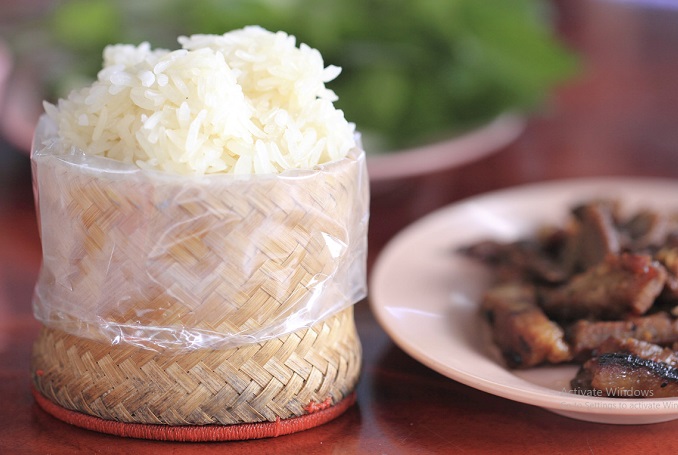 khao niew, or sticky rice.
khao niew, or sticky rice.According to Syhabout, there are 40-plus ethnic groups in Laos, each with its own food preferences and traditions. Though he describes once sharing a meal with the people of a mountain tribe who eat non-glutinous (i.e., non-sticky) rice, for many if not most people in Laos, sticky rice is the go-to variety. Syhabout attributes this to the fact that Lao people eat with their hands. “Sticky rice is like a utensil,” he says, comparing it to the fermented Ethiopian bread injera.
In Laos, sticky rice is cooked in a thip khao, which literally means “rice basket.” These flexible baskets are made from dried stalks or reeds; more elaborate versions have patterns woven into their sides or lids. Sizes vary, from small and personal to large enough for an extended family, although cooking is more commonly done in the larger versions. In restaurants, smaller and more intricately decorated thip khaos may be used as serving vessels after the rice is cooked in a larger basket.
Lao sticky rice is medium-grain, generally white, and somewhat pearlescent, although there are different varieties. It’s commonly steamed in a triangular thip khao suspended over water; it can also be shaped into thin cakes after steaming and then deep-fried, which causes it to puff and crisp, making for some wonderfully crispy rice cakes.
3, Khao Jee (Baguette)
Khao jee is similar to the Vietnamese banh mi – you’ll get a baguette stuffed with lettuce, sliced tomatoes, carrot, onion, moo yor (pork lunchmeat), chopped ham, and topped with pâté or chilli sauce.
You’ll find many road vendors selling this portable Laos street food at rather cheap prices. Khao jee is often enjoyed for breakfast, together with a cup of strong filtered coffee.
4, Jaew Bong (Hot Pepper Dip)
A common Lao condiment, jaew bong is a sticky mass of fish sauce, palm sugar, dried chile, garlic, shallots, and tamarind. The mixture is fried in oil, then cooked at a low temperature to meld the flavors and thicken it up, resulting in a funky, slightly sweet spread with a low-intensity spicy burn. In Laos, dried strips of water buffalo skin are incorporated into jaew bong, which adds a chewiness that’s hard to replicate (water buffalo skin is, unsurprisingly, tough to find in the United States).
Chef Bobby Pradachith, one of the chefs and co-owners of Thip Khao, says, “It’s kind of like having an all-purpose sauce that you have on the side and can serve with everything.” Thip Khao serves jaew bong at the start of every meal alongside sliced raw vegetables. But, Pradachith says, it’s also the kind of condiment that lends itself to being eaten with plain rice, or whatever a person might have on hand.
5, Muu Haeng (Sun-Dried Pork) and Siin Haeng (Sun-Dried Beef)
Muu haeng is thinly sliced pork, typically shoulder, while siin haeng is thinly sliced beef, typically a tough cut with fat, like top round. Both variations are marinated in a mixture of fish sauce, black soy sauce, oyster sauce, and chopped cilantro, lemongrass, garlic, ginger, and galangal, which both flavors and tenderizes the meat.
Pradachith says that in Laos it’s common for muu or siin haeng to be air-dried on the top of a family’s home, where the intense sunlight lends a hand in the drying process. While it is very similar to jerky, the meat becomes tacky and quite chewy, which Westerners might struggle with; Pradachith says this chewiness can be tempered by quickly deep-frying the meat in oil. Muu haeng and siin haeng are most often served as a snack alongside jaew bong, or with rice to make a full meal.
6, Som Moo (Preserved Pork Sausage)
Som moo is made from chopped, fermented raw pork – including the rump and skin – wrapped in green leaves. Fresh chilies are usually mixed into the meat, which adds a spicy kick to this Laos appetiser.
You can enjoy it raw or grilled, though the raw version is preferable among locals. Enjoy som moo with raw cabbage leaves and string beans, which help reduce the sourness.
6, Sai Oua (Herbal Pork Sausage)
Sai oua, the sausage I was hunting for at the night market, isn’t always fermented, but it is a good example of how fermentation can elevate an already-great dish. It’s made with a combination of ground pork and a good amount of fat, which often comes from either pork belly or boiled pork skin that has been roughly ground or cut into strips. The meat is mixed with lemongrass, galangal, ginger, and garlic, then stuffed into natural casings. In the fermented versions, white rice is added before stuffing, providing the starch and sugars necessary for bacteria to develop. The sausages are then left to ferment for one to two weeks, adding a sour note that complements the other flavors.
8, Tam Muk Muang / Lao Papaya Salad (Green-Mango Salad)
 Green-papaya salad is common in both Thailand and Laos, but the Lao version is made with unripe yellow mango. The mango flesh, bright yellow even before ripening, stays crunchy and provides a fresh sour note absent in green papaya. It’s combined with tomato, garlic, and cashew and typically dressed with a mixture of soy and fish sauce, which adds salty and savory flavors, while palm sugar provides sweetness. Because Lao dishes tend to be extremely flavorful, this salad is often less intensely seasoned in order to provide contrast within a meal.
Green-papaya salad is common in both Thailand and Laos, but the Lao version is made with unripe yellow mango. The mango flesh, bright yellow even before ripening, stays crunchy and provides a fresh sour note absent in green papaya. It’s combined with tomato, garlic, and cashew and typically dressed with a mixture of soy and fish sauce, which adds salty and savory flavors, while palm sugar provides sweetness. Because Lao dishes tend to be extremely flavorful, this salad is often less intensely seasoned in order to provide contrast within a meal.9, Lao Sausage
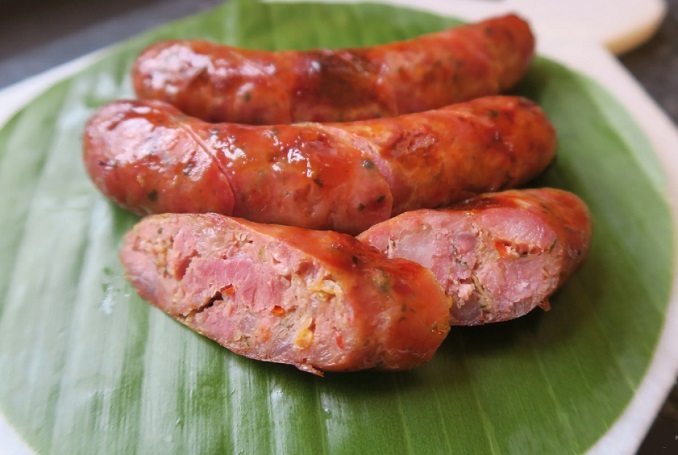 Sai gok (Lao sausage) is a popular Laotian appetiser that’s often eaten with sticky rice and fresh vegetables. It’s usually made with chopped pork meat and seasoned with lemongrass, galangal, kaffir leaves, shallots, cilantro, chillies, and fish sauce. You can find sai gok hanging on hooks at local markets and roadside stalls in Laos.
Sai gok (Lao sausage) is a popular Laotian appetiser that’s often eaten with sticky rice and fresh vegetables. It’s usually made with chopped pork meat and seasoned with lemongrass, galangal, kaffir leaves, shallots, cilantro, chillies, and fish sauce. You can find sai gok hanging on hooks at local markets and roadside stalls in Laos. 10, Naem Khao (Crispy Coconut Rice)
A specialty of Vientiane, Laos’s capital and largest city, naem khao is a mixture of salt-cured ground pork, pig skin, steamed and dried white rice, and dried shredded coconut, which adds texture and body while also soaking up the fish sauce and lime juice. Scrambled egg gives the dish further body and savoriness, ground herbs add flavor and balance, and fresh red curry paste enhances floral notes and introduces fruitiness. It all gets wok-fried to help it crisp. Naem khao is sometimes served with Bibb lettuce leaves, which serve as both a cool counterpoint and edible utensils.
11, Laab Ped (Minced Duck Salad)
Often said to be the national dish of Laos, laab (frequently seen on Thai-restaurant menus as “larb”) is essentially a salad made from ground meat and herbs, laced with fish sauce and lime juice and topped with a powder made from dry ground rice. For laab ped, a variation most commonly found in Vientiane and southern Laos, hand-chopped deboned duck is crisped in a wok, then mixed with fish sauce, dark soy sauce, roasted dry chiles, and lime juice. Fried shallots, garlic, and herbs are added, both for flavor and to temper the gamey meat and savory fat, and mint leaves and toasted rice powder provide color and texture. The dish is meant to be scooped up with lettuce hearts and cucumber, as well as raw Thai eggplant. Small, hard, and globular, Thai eggplants are crisp and sturdy when sliced, and complement the laab with their subtle, vegetal bitterness.
12, Gaeng Som (Chicken Soup With Fish Sauce and Tamarind)
As with khao soi, the base for gaeng som is often a simple chicken broth, but Luangrath says it can be made with whatever leftover meat or bones happen to be available to a family. In a certain way, the dish is also a natural accompaniment to laab of any kind: The bulk of the available meat on a chicken or duck will be used for the salad, and the remaining bones and scraps will go into the gaeng som.
The dish’s name literally translates to “sour soup” (gaeng means “soup,” som means “sour”), and that sourness comes from a sauce made from tamarind pulp, sweetened with a touch of sugar and seasoned with fish sauce. When Luangrath serves gaeng som at Thip Khao, she makes the chicken version, served with chicken thigh and leg meat and garnished with green onion, dried chile, Thai basil, lemongrass, and hon shimeji mushrooms, distinguished by their small brown caps and slender white stalks.
13, Khao Poon (Soup With Fermented Noodles)
This stew is made from bamboo shoots and flavored with yanang leaf extract. Luangrath describes the flavor of the yanang plant, native to Southeast Asia, as similar to that of spinach. Its leaves are thought to have medicinal qualities, though they’re too fibrous and chewy to actually eat. Instead, the leaves are placed in water and rubbed to extract their juices; the extract is then used, along with bamboo shoots, garlic, chiles, and padaek, a type of incredibly strong, unfiltered fish sauce, to make the stew’s base. (Luangrath and Pradachith describe padaek as much stronger, funkier, and more fragrant than the fish sauce most Westerners are likely to be familiar with, and say it’s common to find small shreds of fermented fish floating in it.) The stew’s other ingredients can vary wildly and are usually determined by whatever happens to be on hand, including greens, wild mushrooms, all kinds of herbs, meats like pork or fish, dried fish skin, and whole quail eggs.
14, Piing Hua Jai Kai (Grilled Chicken Hearts)
Piing hua jai kai are a snack commonly found in street markets, threaded on a stick along with other tasty bits of offal. The chicken hearts, which are about the size of a quarter, get trimmed of fat and butterflied down the center before being marinated overnight in a host of ingredients, including ground lemongrass, galangal, ginger, garlic, fish sauce, soy sauce, oyster sauce, and palm sugar. Ideally, they’re grilled just until slightly pink and served while they’re still hot and tender; they are quite unpleasant after they get cold. The flavor of the hearts should be minerally but fresh, with a texture that’s chewy but neither gristly nor cartilaginous. If they seem particularly funky or texturally unpleasant, there’s a solid chance they were precooked and reheated.
15, Lao Pho
Laos pho is a beef noodle soup that originates from Vietnam, but is also commonly eaten by the local population. It has thin slices of beef, pork, or chicken, tripe, meatballs and sometimes innards (heart, liver, or tongue). You can choose to have it with flat or thin rice noodles. Laos pho is often topped with chilli oil, lime juice, bean sprouts, long beans, holy basil, and cilantro.
16, Paa Tod (Crispy Catfish)
Laos may not have a coastline, but it’s got plenty of bountiful rivers (including the muddy Mekong), and catfish is a common catch. Though it can be prepared in a variety of ways, and is often steamed and put in stews, for this particular presentation the catfish fillets are mixed with rice flour and fried until crispy. A dressing made of fish sauce, chiles, palm sugar, garlic, and a hefty dose of lime juice makes this dish bright to the point of incandescence. Sliced red onion and yellow mango are other common additions, and toppings often include sliced mint leaves and toasted cashews. At Thip Khao, Luangrath also likes to add diced firm avocado; it’s not traditional, but the creaminess helps to offset the acidity of the dressing, while complementing the crispy batter of the fish.
17, Sien Savanh (Lao Beef Jerky)
Sien savanh is often eaten as a snack together with Beerlao (lagers produced by the Lao Brewery Company). Similar to beef jerky, it’s made using beef flank steak (some places use water buffalo meat) that’s marinated in a mixture of garlic, fish sauce, ginger, sesame seed, sugar, salt and black pepper.
The strips are then left in the sun until dried. Locals enjoy sien savanh by grilling it over a charcoal stove for a smoky flavour, before eating it with sticky rice or jaew maak len (a tomato-based chilli dip).
18, Muu Som (Rice-Fermented Sour Pork)
This is one of those dishes some Westerners might have a harder time with: Raw pork belly gets massaged and then marinated for approximately three weeks in a wet mash of cold steamed rice mixed with garlic, vinegar, salt, sugar, and water. After the fermentation is complete, the pork is removed and roasted until fully cooked, then charred in a wok with dark soy, ginger, garlic, onion, bell pepper, and mushrooms. This helps the fat crisp up, while the meat remains tender.
The idea of leaving meat to deliberately cultivate bacteria might seem iffy, but muu som, even more than the fermented sausage sai oua, is an example of how spectacular fermented meat can be. The sheer umami joy of cured pork fat is compounded by the process of fermentation, while the flavors of herbs and dark soy, combined with the mushrooms, emphasize the meatiness of the dish. When eaten with the sticky rice, makrut lime, fried shallots, and dried chile that are served alongside, it is as life-affirming as any food can be. Westerners sometimes balk at the idea of eating without utensils, but muu som is the kind of dish where you’ll find yourself using every available grain of sticky rice to sop up the rivulets of fermented pork fat slicking the surface of the plate.
19, Or Lam (Lao Stew)
Or lam is a mildly spicy and thick Lao stew that originates from Luang Prabang. It contains beans, eggplant, lemongrass, basil, chilies, wood ear mushrooms, cilantro, and green onion.
A unique ingredient in this stew is mai sa kaan a locally grown vine that’s not exactly edible (you’re supposed to chew and spit it out). Or lam also contains dried buffalo meat, beef, or chicken meat.
Lao Foods, Laotian foods, lao sausage, Lao Papaya Salad, Laos Cuisine, Lao sticky rice,
1, Khao Soi (Rice Noodle Soup With Fermented Soybean-Tomato Sauce)
2, Khao Niew (Lao Sticky Rice)
3, Khao Jee (Baguette)
4, Jaew Bong (Hot Pepper Dip)
5, Muu Haeng (Sun-Dried Pork) and Siin Haeng (Sun-Dried Beef)
6, Som Moo (Preserved Pork Sausage)
7, Sai Oua (Herbal Pork Sausage)
8, Tam Muk Muang (Green-Mango Salad)
9, Sai gok (Lao sausage)
10, Naem Khao (Crispy Coconut Rice)
11. Laab Ped (Minced Duck Salad)
12, Gaeng Som (Chicken Soup With Fish Sauce and Tamarind)
13, Khao Poon (Soup With Fermented Noodles)
14, Piing Hua Jai Kai (Grilled Chicken Hearts)
15, Lao Pho
16, Paa Tod (Crispy Catfish)
17, Sien Savanh (Lao Beef Jerky)
18, Muu Som (Rice-Fermented Sour Pork)
19, Or Lam (Lao Stew)
Other articles
Lao New Year
Pi Mai Lao is also known as Lao New Year, is aLao festival celebrated at the hottest time of the year..
Read MoreFirst international passenger train on China-Laos Railway departs
The China-Laos Railway officially launched its cross-border passenger train service on April 13, with two international trains..
Read MoreWhat to do and where to see in Luang Prabang?
Adminre the rich architectural and artistic heritage that reflects the fusion of Lao traditional urban architecture with that of the colonial era
Read More15 Amazing Waterfalls in Laos
Laos is chock full of urban and rural tourist sites... , the country is home to many amazing waterfalls too
Read MoreChiang Rai to Chiang Khong Thai - Laos Border Crossing
If you’re heading from Thailand to Laos, there’s a good chance you’ll be following a rough route of...Chiang Rai to Chiang Khong. where you will find the Chiang Khong / Huay Xais border between Thailand and Laos..
Read MoreLaos Travel Ideas
Laos Travelling Idea?! These are the morst popular request and there are availble itineraries to send you imdiately, please do not hetistate to contact us
Read MoreLaos Hidden Gem
Laos is a beautiful country in Southeast Asia that is often overlooked by tourists. However, it is a hidden gem that is worth exploring.
Read MoreLuang Prabang Festival In 12 Months
The city of Luang Prabang in Laos is known for its vibrant and colorful festivals throughout the year. One of the most popular festivals is the Boun Lai Heua Fai or the Festival of Light..
Read MoreLaos Travel Guide
Laos Travel Guide, all question and answer for laos trip you may find here..
Read MoreThings to do and see in Luang Prabang
Luang Prabang is the Laos Capital and also often called the ‘Heart of Laos’ and many visitors choose to come here instead of Vientiane as it is known for its gorgeous countryside and scenic views across the majestic Mekong River.
Read MoreLao Language
Lao is a tonal language similar to Chinese and Vietnamese. Therefore, speakers of Lao and Thai can understand each other, although there are differences...
Read MoreHistory Of Laos
The ancestors of the Lao people were speakers of Southwestern Tai dialects that migrated from what is now southeastern China, specifically what is now Guangxi and northern Vietnam where the diversity of various Tai languages suggests an Urheimat..
Read MoreLaos Weather
For tourists Laos has two distinct seasons (wet summer and dry winter) but for Laos’s population there are technically three seasons; wet, hot and cold. As Laos is landlocked..
Read MoreThings to do in Vang Vieng
Things to do in Vang Vieng: You can spend 3-5 days in vang vieng and don't feel boring with a lots of activities such as Vang Vieng Tubing, kayaking, bikking, trekking..
Read MoreLaos - China Railway
The first passenger train set to travel along the newly completed China-Laos railway was delivered and operated in the Lao capital on Oct 15, 2021...
Read MoreWhich Is The Best Mobile Phone Operator in Laos ?
When providing our Relocation / Welcome Service, one of the first questions asked by our clients is: “Which mobile phone operator should I choose ?
Read MoreLaos Group Tours 's listed "10 Best Laos Tour Operators 2022"
Are you planning to visit Laos, but unsure which tour provider to select? Now, you no longer have to waste time searching the internet and filling out dozens of contact forms
Read MoreLaos Festivals
Despite a communist takeover in the mid-1970s, the landlocked country of Laos remains a Buddhist nation in everything but name...
Read MoreTripAdvisotr's Top Viewed Pictures Of Laos Attractions Taken By Customers
Below is the top beautiful pictures of Laos Attractions tacken by our customer which they put on TripAdvisor.com
To view large picture click on the picture
 Do not hesitage to give us a call. We are an expert team and we are happy to talk to you.
Do not hesitage to give us a call. We are an expert team and we are happy to talk to you. 






